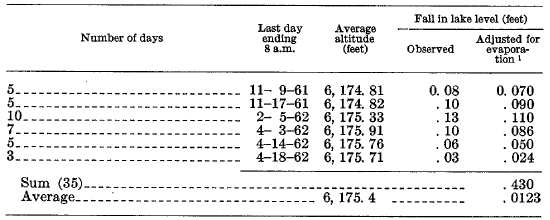Hydrology of Crater, East and Davis Lakes, Oregon by Kenneth N. Phillips
CRATER LAKE
WATER LOSS FROM THE LAKE
SEEPAGE LOSS
It has long been recognized that some of the water in Crater Lake is continuously being lost by seepage. In 1913, when the lake level was near 6,176 feet altitude, F. F. Henshaw estimated the seepage rate at 83 cfs (U.S. Geol. Survey, Portland, Oreg., unpub. data, July 29, 1913). Van Winkle (1914, p. 42) stated that-“some of the water may find its way by percolation into Rogue River, but more of it probably goes southward, appearing as springs in the drainage basin of Klamath River.” S. T. Harding (written commun., 1953), on the assumption that annual evaporation loss was 36 inches, estimated that seepage was about 58 cfs.
The trace of a continuous water-level recorder was used to ascertain the average rate of seepage loss from the lake in selected dry and cold periods in 196 1-62 (table 4). That recorder was installed in Cleetwood Cove on September 14, 1961. The datum of its reference gage is the same as that of the former staff gage on the southwest shore and was ascertained by water level in periods of calm. Ordinary waves are damped out by the inlet to the water-stage recorder, and the water level can be ascertained within 0.01 foot except in rare periods of high wind.
From November ‘4, 1961, to April 18, 1962, there were six periods, each of 3 to 10 days’ duration, in which no precipitation was recorded at Crater Lake Weather Station. Table 4 shows the fall in lake level during these periods. The evaporation rate was undoubtedly very low, because the water surface was cold and at times partly frozen. Relative humidity i’s generally high in such periods. Nevertheless, an average loss by evaporation of 0.002 foot per day (equivalent to 13 cfs) was assumed. Temperatures were generally low, and runoff from the peripheral tributary area of 5.64 square miles would have been minimal, but deep percolation would have continued, and an average runoff rate into the lake of 8 cfs was assumed.
The average seepage rate computed for the six short periods listed in the table was 89 cfs. That rate is applicable to a stage of 6,175.4 feet, the average level of the lake in the period November 1961 to April 1962.
| TABLE 4.-Fall in level of Crater Lake in selected periods of no precipitation, 1961-62 |
 |
1 Evaporation rate of 0.002 foot per day assumed.
***previous*** — ***next***

